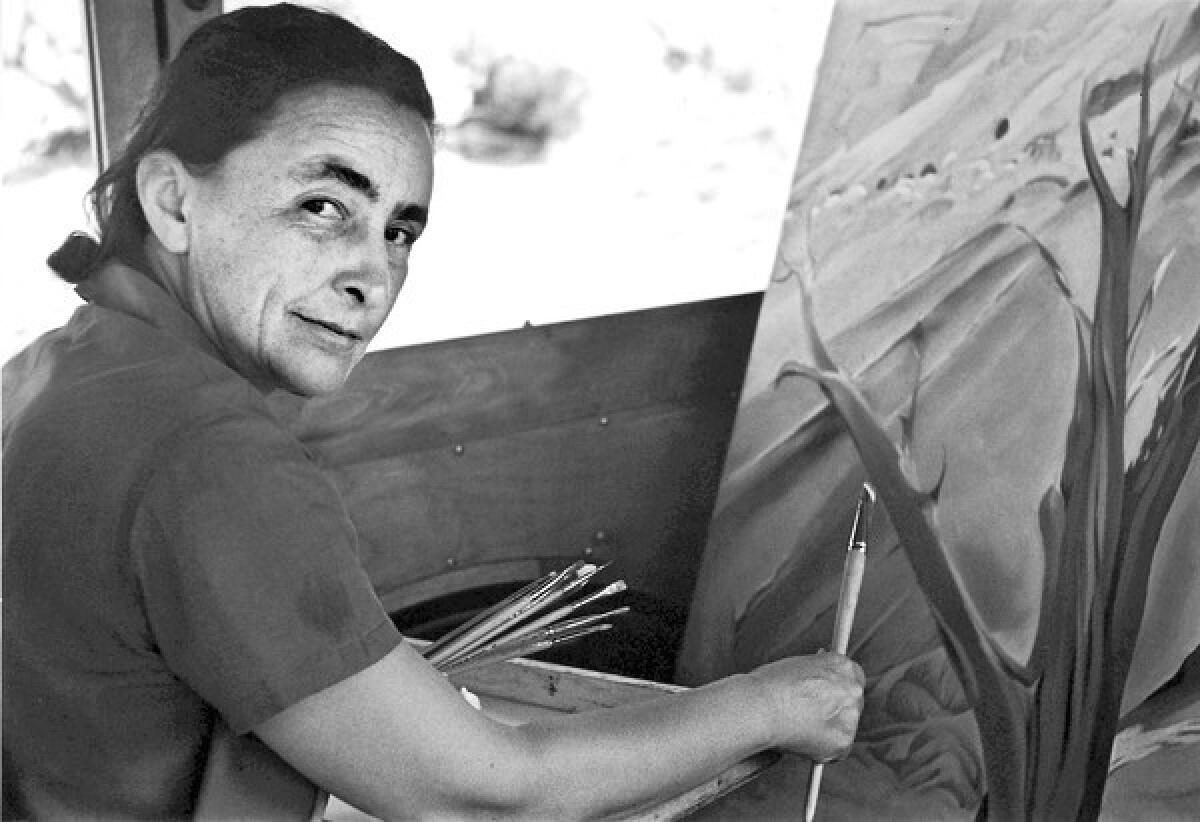Book review: ‘My Faraway One’

- Share via
My Faraway One
Selected Letters of Georgia O’Keeffe and Alfred Stieglitz: Volume One, 1915-1933
Edited by Sarah Greenough
Yale University Press: 832 pp., $39.95
At the beginning of their correspondence, in 1915, she addressed him as Mr. Stieglitz. He called her Miss O’Keeffe. Within a few years, he was Dearest Duck and she was Fluffy.. By 1933, when the first volume of their letters ends, much more than appellations had changed. Photographer Alfred Stieglitz and painter Georgia O’Keeffe had evolved from acquaintances to lovers and then from marital partners to distant combatants struggling to maintain a passionate relationship despite his infidelities and her quest for independence.
Much has been written about Stieglitz and O’Keeffe — his pioneering modern art galleries and photographic work, her paintings of enormous flowers and Southwestern landscapes, their epic love affair. But “My Faraway One” is not just one more big book about the couple. It’s a substantial sampling of a huge trove of correspondence that was sealed until 2006, 20 years after O’Keeffe’s death, and the first annotated selection of those letters to appear in print.
For the first volume, Sarah Greenough — senior curator and head of the department of photographs at the National Gallery of Art in Washington, D.C., and author of many books on photography — chose about 650 examples of the more than 5,000 letters exchanged by O’Keeffe and Stieglitz over three decades. Volume Two will cover 1934 to 1946, the year of Stieglitz’s death, and is tentatively scheduled for release in 2014.
The notion of penning so many letters is almost unfathomable in an age of electronic communication. For O’Keeffe and Stieglitz, who spent a great deal of time apart, writing was essential to keeping up with each other’s art work, daily activities, emotional swings and sexual yearnings. And write they did, in a more or less stream-of-consciousness style with lots of dashes.
“It’s so funny that I should just write you because I want to — I wonder if many people do. — You see — I would go in and talk to you if I could — and I hate to be completely outdone by a little thing like distance,” O’Keeffe wrote in 1916. At the time, she was a 28-year-old artist whose work had just been discovered by Stieglitz; he was a 52-year-old force in the American art world, married to Emmeline Obermeyer, a brewery heiress.
In the early years of their correspondence, O’Keeffe taught art in South Carolina and Texas while Stieglitz was in New York making photographs, operating the gallery known as 291 and publishing Camera Work magazine. Later, they spent long periods, together and individually, at the Stieglitz family home in Lake George, N.Y. As their relationship became troubled, O’Keeffe vacationed with friends and summered in New Mexico. Although she owed her early success to Stieglitz and loved him deeply, she bolted when she felt constrained or couldn’t cope with his other female interests, including Dorothy Norman, a wealthy young married woman, with whom he had a 20-year affair.
Greenough, a Stieglitz authority and trusted friend of O’Keeffe’s, provides the necessary framework for the inevitably fragmentary saga that twists and turns through the letters. With extraordinary insight and a deft touch, she offers historical and social context and examines issues that united and divided two volatile personalities.
But, above all, “My Faraway One” is a love story, told by artists who inspired and energized each other — and whose differences in age and temperament could seem insurmountable. In a letter written in 1917, Stieglitz asked O’Keeffe if she wanted to have his child. She responded affirmatively, but nearly a year later he wrote that any child they had “would be drowned to death” along with its parents because he didn’t “know how to be part of the big game.”
They began their unconventional marriage in 1924, three months after Stieglitz’s divorce. Greenough points out that his refusal to have a child with O’Keeffe and his promotion of her art as an expression of her gender became major points of contention. But O’Keeffe was every bit as strong and willful as her husband. And her love affair with New Mexico, her eventual home, started early.
On her first trip there, in 1917, she responded ecstatically, writing that “the square little adobe houses are great — I’m crazy to live in one.” In 1929, when she began spending summers in New Mexico, Stieglitz agonized over the separation, almost to the point of hysteria, but acknowledged “a terrible rightness” to their new lives.
But their correspondence continued. In the final entry of this volume, Stieglitz ushered in a new year and his own birthday with a letter to O’Keeffe: “The City is agog with whistles & bells — sirens — I have been in bed — I jumped up to say Hello …Oh, Georgia. — And I am seventy finally. — I never expected to see that age. — Yes seventy. — And you on the road to full recovery. — That’s my gift from you. — Again much, much love — I’ll hop into bed again. — Another kiss — the first in 1934!”
A former Times staff writer, Muchnic is the author of “Odd Man In: Norton Simon and the Pursuit of Culture.”
More to Read
Sign up for our Book Club newsletter
Get the latest news, events and more from the Los Angeles Times Book Club, and help us get L.A. reading and talking.
You may occasionally receive promotional content from the Los Angeles Times.









